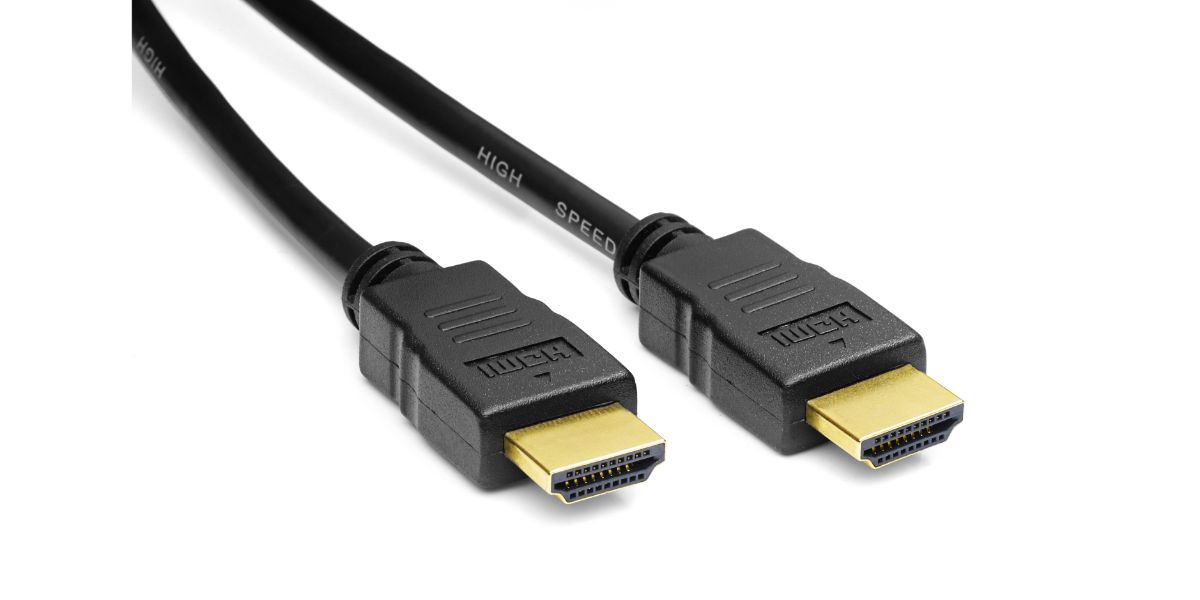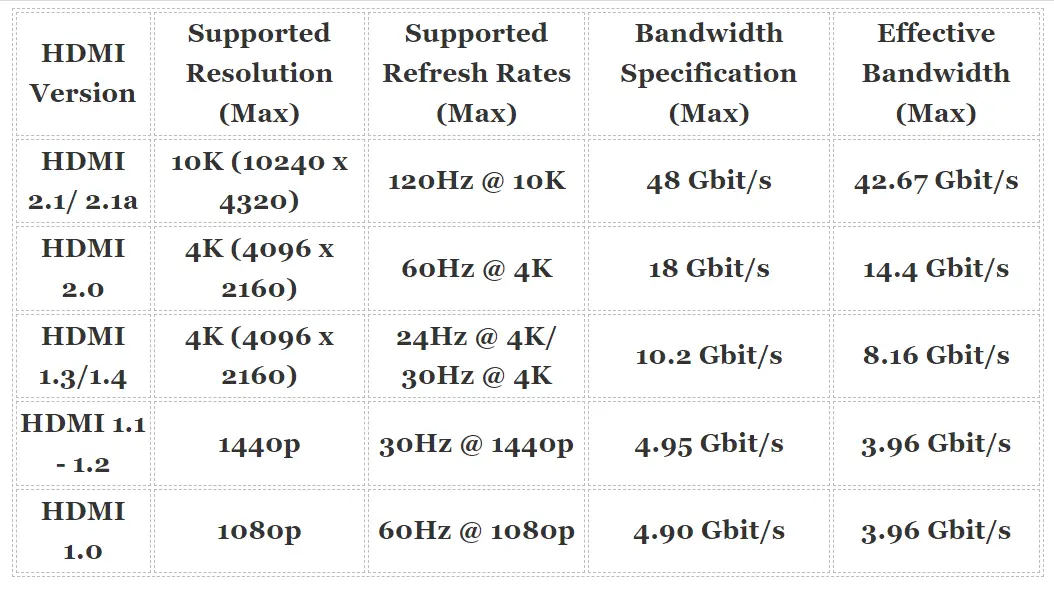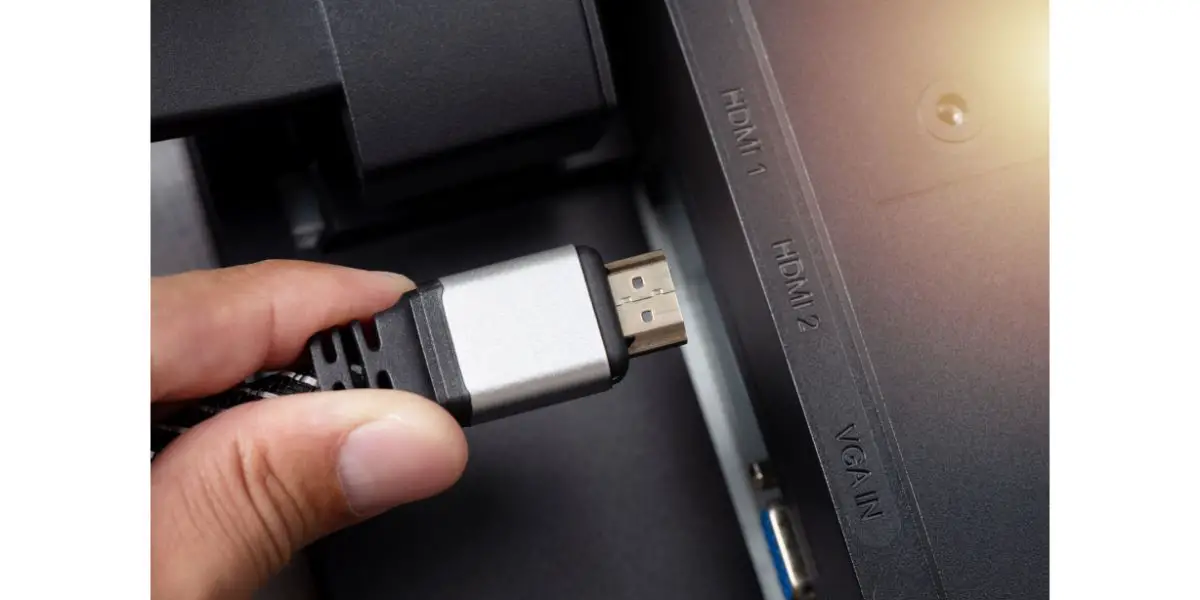Disclaimer: This post may contain affiliate links, meaning we get a small commission if you make a purchase through our links, at no cost to you. For more information, please visit our Disclaimer Page.
HDMI 2.1/ 2.1a and HDMI 2.0 offer comprehensive support for 144Hz 1440p resolution. HDMI 2.0 has become the standard for most modern monitors and TVs, but you will need a compatible HDMI cable to enjoy uncompressed 1440p at a 144Hz refresh rate.
In this post, we’ll look into different HDMI versions and cables while explaining the configurations needed for 144Hz 1440p so you can make the most of your monitor.
Table of Contents
What HDMI Version Supports 144Hz 1440p?
Two of the latest HDMI generations support 1440p resolution at a 144Hz refresh rate without sacrificing color quality. These are the HDMI 2.1 and the HDMI 2.0.
- HDMI 2.1: The latest generation HDMI version is 2.1, which has received a minor update in the 2.1a version. The port offers native support for 144Hz for the most popular gaming resolutions, starting from 1080p Full HD to 4K UHD. It also supports 8K but at a 60Hz frame rate.
- HDMI 2.0: The slightly older HDMI 2.0 also offers full support for 144Hz frame rates at 1440p and 1080p resolutions. You can also achieve 60Hz at 4K UHD. If you don’t mind 1080p, you can enjoy as much as 240Hz refresh rates using HDMI 2.0.
You don’t necessarily have to go above and beyond to find an HDMI 2.1-supported monitor or graphics card to enjoy 144Hz refresh rates.
It’s a reasonably new connector that would take some time for broader availability. Until then, you can make do with HDMI 2.0, which supports higher and lower resolutions well.
HDMI 1.3/1.4 connectors also support 144Hz refresh rates, albeit at the reduced 1080p resolution.
These connectors can hit 144Hz at 1440p, but only for compressed color quality at 4:2:0 chroma subsampling. The compressed color quality means that your experience will be affected slightly as the colors will simply not look the same as with a more recent version of HDMI.
What is the Required Configuration for HDMI 144Hz 1440p?
As discussed above, you can enjoy 144Hz refresh rates at 1440p resolution using different HDMI versions. However, you will need more components than a capable HDMI connector to achieve this result.
HDMI 144Hz 1440p requires an HDMI 2.0 or HDMI 2.1 connector, a capable monitor, a graphics card, and a cable that supports the required bandwidth. You will only get the expected result if all these elements are compatible with 144Hz at 1440p.
The Different Capabilities of HDMI Versions
Different generation HDMI ports have a particular support range for refresh rates, resolution, and bandwidth. Therefore, your monitor and cables must support this specific range for a desired output.
Let’s have a look at the table below to learn the capabilities of each HDMI generation:
As you can see, different HDMI connectors support specific bandwidths. Nevertheless, the practical maximum bandwidth is always less than the connectors’ full bandwidth specifications.
What is the Bandwidth of a Monitor?
The bandwidth signal of a computer monitor refers to its data rate or flow capacity for digital information. You need this information to find a suitable HDMI cable. Note that your cable’s maximum bandwidth should exceed your configuration’s requirement.
Ensuring the cable’s maximum bandwidth is higher will help negate the difference between the specified and actual bandwidth.
How To Calculate the Bandwidth of Your Monitor?
You can calculate the bandwidth of your monitor by multiplying its resolution, refresh rates, and bit depth. Each of these variables has a correlated impact on the monitor’s bandwidth. The more resolution, refresh rate, and bit depth it has, the more information the monitor will produce.
You must consider the monitor’s horizontal and vertical resolution for calculating data rate. You also need to use bit or color depth per pixel, not the bit rate per channel (bpc), which can be found by multiplying the bpc by three.
Considering the most important elements, a formula for calculating the approximate bandwidth of your monitor would be as follows.
H (Horizontal pixels) x V (Vertical pixels) x B (Bit depth) x (Refresh rate in Hertz).
For example, if you have a 24-bit monitor with QHD resolution (2560 x 1440), its raw data requirement at 144Hz refresh rate could be calculated as follows.
2560 x 1440 x 24 x 144 = 12,740,198,400 bit/s = 12,441,600 Mb/s ~ 12.44 Gbit/s.
As calculated, the example monitor would require an HDMI connector and cable that supports more than the 12.44 Gbit/sec bandwidth for uncompressed image quality.
Other variable features like blank intervals also affect the data requirement, but calculating those manually requires a more complicated formula. Instead, you can use this bandwidth calculator online to find the specific configuration quickly.
HDMI Cables With Support for 144Hz 1440p
The HDMI Licensing Administrator labels different cables with a specific certificate that denotes their types and capabilities. You can check the cable certification to find the right one for your needs.
Several HDMI cable types are available in the market, only a few of which support 144Hz at 1440p resolution. Here are two HDMI cable types you can use.
- Ultra Certified HDMI Cables: The cables with an ‘Ultra Certified Cable’/‘Ultra High Speed’ label supports the latest generation HDMI 2.1 connectors. With up to 48 Gbit/s bandwidth, it can support all HDMI 2.1 features, including 1440p @ 144Hz.
- Premium Certified HDMI Cables: The cables with a ‘Premium Certified Cable’/ ‘Premium High Speed’ label come with at least 18 Gbit/s bandwidth capacity to support up to 4k @ 60Hz on HDMI 2.0. You can comfortably use these for 144Hz 1440p.
Some premium high-speed HDMI cables have a dedicated ethernet data channel for streaming. You can learn how HDMI with ethernet works from our post here.
Are HDMI Ports and Cables Backward Compatible?
All HDMI connectors are backward and forward-compatible, so you can connect devices with different HDMI ports to work together. For instance, connecting a monitor with an HDMI 1.4 connector to an HDMI 2.0 CPU is possible or vice versa.
The same applies to HDMI wires, where a cable with 48 Gbit/s bandwidth would work fine with HDMI 2.0 or other previous-generation ports.
However, the performance of a backward/ forward configuration will be capped at the level of the least capable component, whether it’s the port or the cable.
Conclusion
The last two generations of HDMI ports support 1440p resolution at 144Hz without any compressions, while the HDMI 1.3/1.4 supports it at a compressed quality. Just make sure to calculate the bandwidth of your configuration and find a compatible HDMI cable to enjoy a seamless experience.



